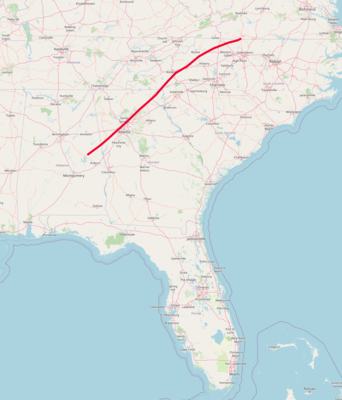Brevard Fault
The Brevard Fault Zone is a 700-km[1] long and several km-wide thrust fault that extends from the North Carolina-Virginia border, runs through the north metro Atlanta area, and ends near Montgomery, Alabama. It is an important Paleozoic era feature in the uplift of the Appalachian Mountains.[2]

Discovery
Arthur Keith from the United States Geological Survey first identified an exposed segment of the Brevard Fault in 1905,[3] believing it to be a syncline. In 1932, Anna Jonas Stose’s used local petrology to identify the site as a thrust fault.[4] Stose, the first to trace the fault, is also credited with identifying that the rocks in the area must have been formed through deformation,[5] placing the Brevard Fault in a regional perspective.[3] Using modern methods of seismic reflection and high-resolution profiling, geologists have since discovered that the Brevard Fault Zone has undergone both thrust and strike-slip movement.[6]
Geology
The Brevard Fault Zone is a part of a much larger system of faults at the base of the Appalachian thrust sheet[1] that played a key role in uplifting the Appalachian Mountains. The extent of its role remains uncertain because most of the fault is buried beneath Quaternary sediment.[7] Many studies of the fault come from Grandfather Mountain in the Linville Fall Quadrangle,[8] which contains the exposed region that was first discovered by Arthur Keith. This region is only 1–3 km of its 700 km length.[7]
The Brevard Fault experienced multiple phases of deformation and minimal stratigraphic displacement.[3] The Brevard Fault Zone contains diverse lithologies, but it is primarily composed of mylonitic metagraywacke, schist, amphibolite, and gneiss[9] that underwent metamorphism 350–360 million years ago.[1] The Fault Zone is characterized by ductile behavior as indicated by the widespread presence of mylonitic and phyllonitic rocks.[1]
See also
Bibliography
- Lua error in Module:Cite_Q at line 13: attempt to index a nil value.
- Lua error in Module:Cite_Q at line 13: attempt to index a nil value.
- Lua error in Module:Cite_Q at line 13: attempt to index a nil value.
References
- ^ 1.0 1.1 1.2 1.3 Lua error in Module:Cite_Q at line 13: attempt to index a nil value.
- ^ Lua error in Module:Cite_Q at line 13: attempt to index a nil value.
- ^ 3.0 3.1 3.2 Bobyarchick, Andy (1999). "The history of investigation of the Brevard fault zone and evolving concepts in tectonics". Southeastern Geology. 38 (3): 223–238.
- ^ Dietrich, R. V. (1974). "Memorial to Anna I. Jonas Stose" (PDF). Geological Society of America. Archived (PDF) from the original on 2019-02-09.
- ^ Jonas, Anna Isabel (1932). "Structure of the metamorphic belt of the southern Appalachians". American Journal of Science. s5-24 (141): 228–243. doi:10.2475/ajs.s5-24.141.228. ISSN 0002-9599.
- ^ Gore, Pamela J. W.; Witherspoon, William D. (2013). Roadside Geology of Georgia. Missoula, Montana: Mountain Press Publishing Company. p. 187. ISBN 978-0-87842-602-7. OCLC 872634030.
- ^ 7.0 7.1 Hatcher, Robert D.; Huebner, Matthew T.; Rehrer, Justin R.; Acker, Louis L.; Fullagar, Paul D.; Liu, Angang; Goad, Patricia Lee (2017). "Geologic and kinematic insights from far-traveled horses in the Brevard fault zone, southern Appalachians". Linkages and Feedbacks in Orogenic Systems: Geological Society of America Memoir. 213: 313–351. doi:10.1130/2017.1213(13). ISBN 9780813712130.
- ^ Reed, Jr., John C. (1964). "Geology of Linville Falls Quadrangle North Carolina" (PDF). Geological Survey Bulletin. 1161-B: B3.
- ^ "Mineral Resources Online Spatial Data". USGS. Archived from the original on 2018-06-25.